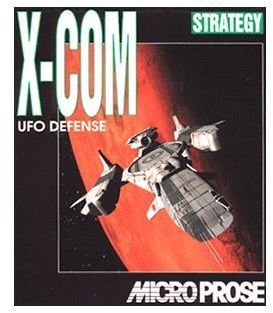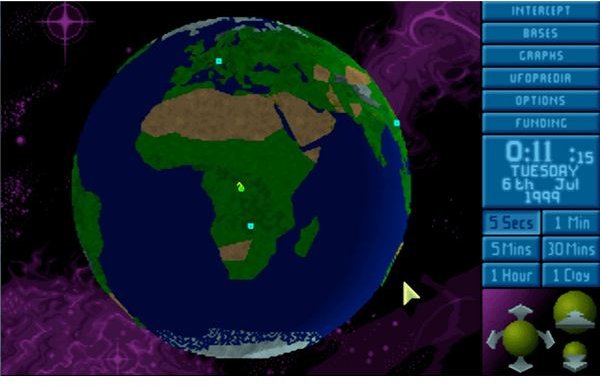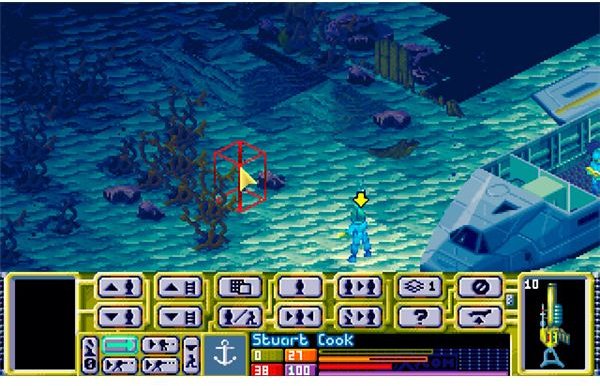The X-COM Legacy: The Geoscape

X-COM: UFO Defense Starts the Series Off With a Bang!
Back in the dark ages of DOS gaming, when players were still juggling multiple autoexec.bat and config.sys files, fine tuning the amount of resources each game needed to be played on boot (thus forcing a myriad of boot disks, or menu options, once those became implemented in DOS 6.0 if memory serves me right), a well-known publisher known as MicroProse released X-COM: UFO Defense, and many players got to experience an incredibly deep and rewarding strategy gaming masterpiece. This title combined a tricky resource management half that ran in a sort of combined real-time and turn-based way with a turn-based, nail biting squad combat engine that put you in charge of soldiers that you took the time to recruit and outfit within the resource management section of the game. There was a lot to do and to manage, but the developers balanced it perfectly, though to many it presented an extremely frustrating challenge at times. This was X-COM.
UFOs, Panic, and Politics!

The way X-COM operates is quite interesting, and it is somewhat a shame that even to this date, we don’t see this format used very often, if at all. At the very beginning, the game tasks you with choosing a spot for your base. This is a very important decision, as you will not be able to go too far from your base at the very beginning, and if you place your base too far from powerful countries you risk making them unhappy with your performance and they will penalize you by reducing their funding.
So yes, the first thing to keep in mind is that a happy country seeing alien invasions getting thwarted will give your X-COM forces much more money than an unhappy nation that sees panic spread in its streets as aliens invade, do away with their people, and your forces can’t do much to prevent the problems. Basically, if your only base is in the US, by the time you get to a panic zone in Russia, it may be too late already. Likewise, because you only have radar arrays setup in your bases, you may not pick up alarming UFO activity in China. Thus, the first part of the strategy is happening before you have even picked up on your first UFO. How to handle the size of the world with your limited resources as a starting extraterrestrial fighting unit? Do you begin by building a powerful base in one section of the world, risking alien incursion elsewhere, or do you build little outposts scattered around, hoping to turn them into better bases eventually as you accrue more funds? Remember that countries that get hit hard by the aliens will cut down on their funding, and they may even create secret alliances with the aliens in order to survive the ordeal.
You manage all of this from a screen that shows the Earth, with some simple controls to spin the globe around and look at a different part of the planet. Now, time is running constantly in “ticks”, and you can set whether each one of those ticks makes 5 seconds, 1 minute, 5 minutes, 30 minutes, an hour, or a full day pass in game time. Of course, to call this fully real time would be a misnomer, as the game pauses every time an event happens or whenever you need to go into your bases to perform any administrative task. This includes everything from building new modules for your base, affecting its layout (which you need to keep in mind as your base layout will serve as its combat map if it gets invaded by aliens), to buying combat supplies, new vehicles, and performing research on alien artifacts or corpses. Yes, you were given the reins to a powerful organization that gets to do everything related to aliens, from fighting them to researching and understanding them, and you get to call the shots on every aspect of the mission.
Strategic Turn-Based Combat

The combat is possibly X-COM’s most well-known feature, and at times its most hated by the uninitiated. You can have as many soldiers at your disposal as you can afford, but you can only bring the amount that actually fit inside a transport vehicle into a combat zone. Once there, you can choose the weapons they’ll be carrying and any other miscellaneous items by way of a paper doll like interface. Now, you may want to load up all your soldiers with the strongest, heaviest weapons possible but that’s both expensive and problematic. An encumbered soldier is a compromised unit with little mobility and impaired reactions times. Yes, those stats matter.
X-COM, while a whole new series, borrows heavily from other titles that were previously designed by Jullian Gollop, particularly Laser Squad. Basically, each unit has a very important stat, the Time Units. These dictate how many actions a unit can perform in a turn, and these Time Units are depleted by walking, crawling, firing a weapon (and it varies by weapon and chosen fire mode, for instance a pistol will use fewer time units than a rifle when fired, and both will use fewer time units if they’re fired “from the hip” than if you perform an aimed shot with them), and so on. You can even opt to save Time Units, so that you can interrupt enemy actions during their turn! The way that works is that you can choose to end your turn before your soldiers have run out of Time Units, so that if they see the aliens as they are acting they will react and use those Time Units up by firing at them.
Now, in order to identify these aliens they need line of sight, and the game makes wonderful use of terrain and barricades in order to obstruct said line of sight. There is also heavy fog of war use, so you don’t know what a level’s layout is until soldiers from your team have actually “seen” their surroundings. Likewise, an alien may be hiding around a corner, waiting to get a quick shot at your units, but they won’t know until they’ve confirmed its position. This can make for a very intense combat experience, as you never know what’s lurking behind a corner, and your soldiers are unable to survive much enemy fire at first, usually dying after one single shot. You need to balance flushing out aliens with staying behind cover and saving enough Time Units to fire off a shot if an enemy comes into line of sight: some troops move while others cover, making for a very cool tactical experience.
Adding even more aspects to keep in mind, the aliens are not stupid in any way, and thus you must design your strategy with care. If you just land your vehicle in a combat zone and have every soldier exit immediately, you run a very real risk of getting ambushed, possibly losing a soldier or two, which can make your units lose morale and even panic, firing their weapons randomly or dropping them altogether and running away! Aliens can also react like that, depending on how the fight goes (and on their race; some will panic more easily than others).
Improve your Technology, Master Theirs!
As previously stated, you also get to control a research aspect of the game, improving human technology to fight the aliens and reverse engineering their own technology in order to even the odds. You can also set teams of scientists to study alien biology to understand them, and even capture live ones to interrogate and learn about their plans and where their main base is.
Once you’ve figured out their technology, you can use those weapons yourself, and even create new armors and weapons using their materials. Of course, this means hiring engineers and setting apart manufacturing space for all of these details. When I mentioned that you were in charge of everything that the X-COM unit needs to do, it was no joke. And doing all of this takes time, so you may end up in situations that you’re almost ready to go manufacturing some fancy new power armors, but you also have 3 alien panic raids going and you can’t wait for the armors to be ready. Or, maybe that psionics training center is almost good to go and you’re itching to train your soldiers in the use of psionic abilities when the aliens decide they’re fed up with how you keep foiling their plans and they decide to strike into one of your bases, possibly the one where said psionic center is still under construction.
Unfortunately, the research tree in the second title, Terror from the Deep, exhibits some anomalies that could lead to game breaking bugs. They’re easy to avoid however, as long as you stick to a few rules (these are taken from Ufopaedia.org):
- You should only research the Deep One Terrorist after you have complete research on Plastic Aqua Armor and Ion Beam Accelerators.
- You must have at least one Sub Construction in storage before completing research on Zrbite and/or Transmission Resolver.
- Never research the Tasoth Commander as they can block the T’Leth research.
- Do not research the Molecular Control Lab unless you have at least one Molecular Control Reader in storage.
- Never sell all of your Sonic Pistol Clips before researching it first. If you were to research the Sonic Pistol, the aliens immediately stop using that weapon (and thus, clip) so you will be unable to continue in the Sonic line of research.
Any of the above (other than the Molecular Control reader) would make it impossible to finish the game. Ironically, the first installment X-COM: UFO Defense, only had one major research bug: completing research on the Floater Medic will freeze the game, so don’t.
Terror From the Deep
The original X-COM was quite a hit, so what do game companies do when they have a hit on their hands? Well, they publish a sequel of course! X-COM: Terror from the Deep is that first sequel, but it feels sort of like an expansion pack rather than a real sequel to the original.
Terror from the Deep continues exactly from the point that the original ends. The aliens’ secret base on Mars is destroyed, but before it went down, it sent a beacon towards the earth, awakening an ancient threat that was hiding within the deepest recesses of our oceans for many millennia, and so X-COM can’t rest just yet.
The main differences between this sequel and the original, is that Terror from the Deep takes place almost entirely under water, so now you need to build your base in an ocean rather than on ground. You will also be intercepting alien submarines, sinking them and engaging the survivors under water. This accounts to what is mostly a cosmetic difference, as the combat works exactly the same way. Of course, you end up developing different weapons, as lasers just won’t fire too well under the ocean, but all the basics are the same. You will build your base, intercept alien vehicles, engage in squad-based combat, research the corpses and artifacts, take live alien hostages to interrogate and research, etc. Panic missions still take place above ground, and you will engage in multiple stage missions from time to time.
It’s certainly an excellent video game, but it’s not as ground breaking as the original.
Apocalypse

The third title in the series, and the last one designed by Jullian Gollop, X-COM: Apocalypse was an interesting evolution from the original design. While not a complete departure, it did have enough differences to set itself apart from the preceding titles quite effectively.
Set 50 odd years after the events in Terror from the Deep, the earth has become a very inhospitable environment due to damage from the previous wars with the alien empire. As such, humanity now needs to live in several self-contained cities, the first of which, Mega Primus, forms the setting for this title. As expected for a sequel, a whole new alien threat has emerged, but the new aliens come from dimensional gates that they open into the city rather than flying in within UFO’s. Your aim is to take the fight to the aliens’ home dimension and keep them away for good.
Now, the fact that the game works from within a single city rather than the whole planet may seem as if it’s simpler than the previous titles, but the more specialized focus has added some new considerations. It’s not just about stopping UFO’s and capturing aliens now; you also have to minimize collateral damage. Your operations are being funded by private corporations rather than the nations of the world, and they are somewhat more strict on what they allow you to do.
The combat system has also been overhauled, allowing a real-time option (though you can pause to issue orders). You can also opt for a turn-based system as previous titles, but the real-time option really shines, and adds a very unique flavor to this installment.
More Sequels, More Genres
The first three X-COM titles provided very well balanced and finely tuned gameplay experiences that few games dare try to equate, even to this date. Unfortunately, as is the case with successful franchises such as this, MicroProse (which belonged to Hasbro), decided to publish several sequels that were not developed by the original designers and that spanned different genres.
Interceptor was the first of these sequels, a space combat title that tried its best to translate the main concepts of the series into a space flight sim. The player would explore the universe with technology retrieved from the aliens, searching for alien craft and shooting them down, researching, etc. While not an unenjoyable title per se, it really suffers from deviating from the tone of its source material, trying to be humorous with its campy tone and numerous pop culture references to Star Trek, Star Wars, E.T, etc.
Then there was Enforcer. The concept is very sound in practice. They wanted to create a third person shooter that took place during the first alien war in 1999. However, they chose to make the player a robot warrior rather than an X-COM soldier, and as such the game takes place in an alternate reality rather than within the proper X-COM universe. From what I understand, it was an intense shooter, but did not bear its pedigree very well. Unfortunately, I’ve never played this one, so that’s all I can say about it.
Laser Squad Nemesis: The X-COM Series Has Come Full Circle
While the X-COM series may be dead right now, that doesn’t mean that its excellent gameplay has been lost in time. The original designer of the franchise, Jullian Gollop, has continued to refine his special brand of squad-based tactics gameplay, but away from the X-COM brand name as it does not belong to him. He went back to an older franchise to continue his work, and that is how Laser Squad Nemesis has come to be.
Laser Squad Nemesis removes the management aspects altogether, and simply focuses on squad-based combat. However, even though it shares its name with an earlier title from his career, this title has little to do with the original Laser Squad except for its inspired gameplay.
Unlike his previous titles, Laser Squad Nemesis allows the player to choose a faction from four different races. The human Space Marines, the Zerg-like Spawn, the robotic Machina, and the alien Greys (which were not present in the title’s original release). All sides are intricately balanced, and the title keeps the familiar Time Unit system which is sure to please fans of the original X-COM titles. Originally a multi-player focused title, the latest release includes a single player campaign as well.
X-COM Lives On
While there have been no new developments within the X-COM series proper, you can still acquire the titles in this series for a very low fee on Steam or on Direct2Drive. Though their graphics have certainly not aged very gracefully, their timeless gameplay is every bit as compelling now as it was then.
So, if you’re curious about it, choose where to acquire the titles and enjoy some of the best strategy video games ever counceived.
Now, if you’re interested in alternatives with similar concepts, a few developers gave it their best shot. Some of those titles with similar concepts are:
- UFO: Aftermath and its sequels (which is interesting, as the original name for X-COM: UFO Defense was UFO: Enemy Unknown)
- UFO: Alien Invasion (an open source project, it’s worth checking out)
- Rebelstar Command (a GBA title from the designer of the original X-COM and Laser Squad, it also shares its name with an older release of his predating Laser Squad)
- Laser Squad Nemesis
What a Series!
The X-COM series has won numerous accolades, including IGN’s “Best PC Game of all Time” in 2007 for X-COM: UFO Defense. It also appeared as number 22 on Computer Gaming World’s list of the best games of all time in 1996.
But hey, don’t take their word. If you get a chance, try these classics and forge your own opinion. The worst that can happen is that you end up hopelessly addicted, like many of us were back then. You get bonus points if you can track down the Sony Playstation version of X-COM: UFO Defense! I never did, but I’m extremely interested in finding out if any of it got dumbed down…
